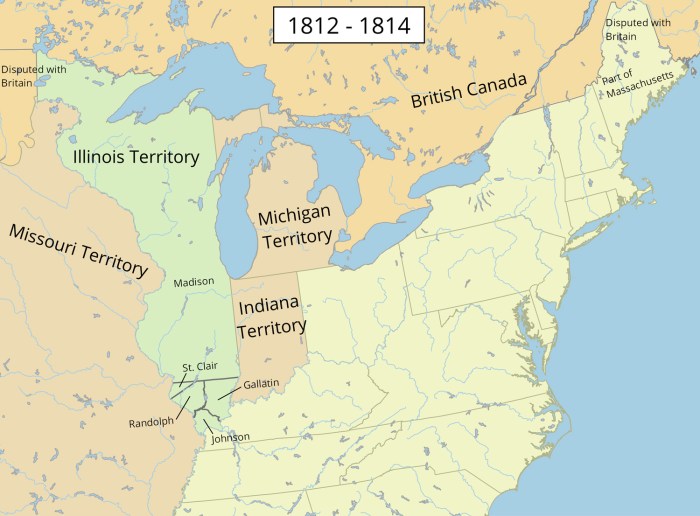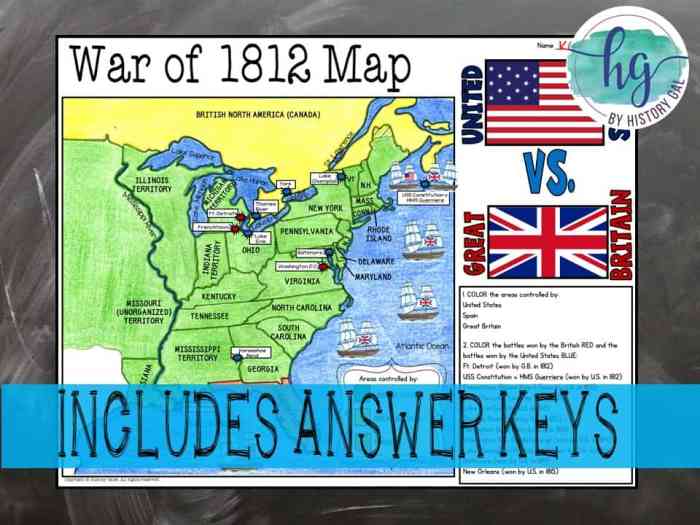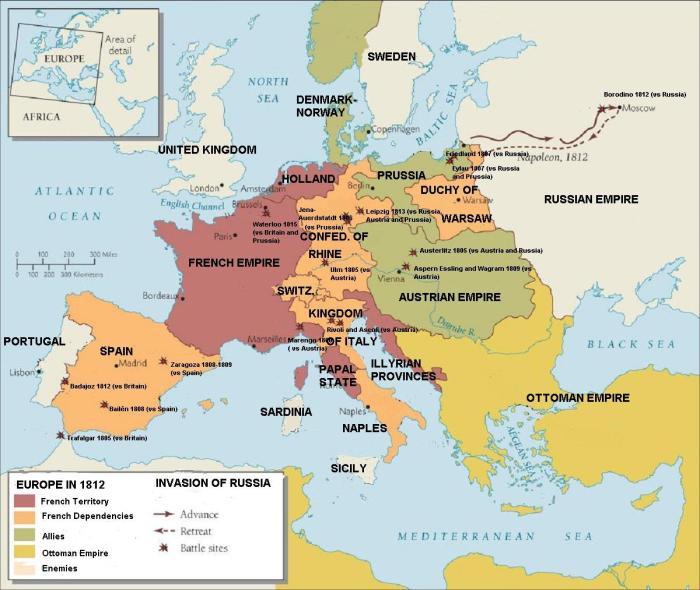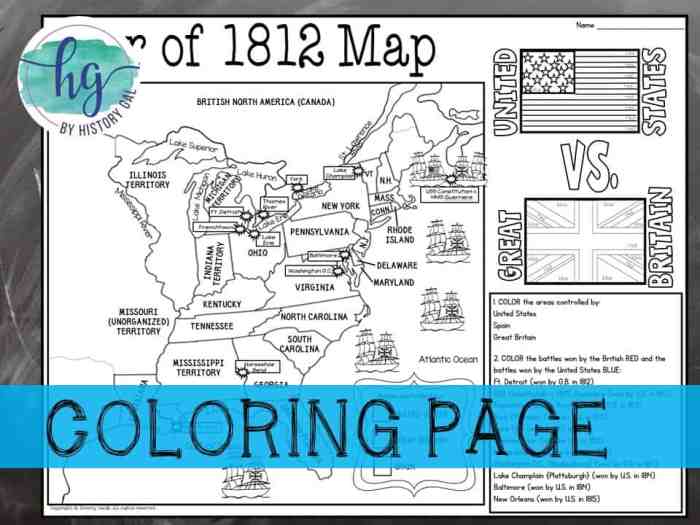Unveiling the War of 1812 Map Answer Key, we embark on a captivating journey through the intricate web of battles, territories, and events that shaped this pivotal conflict. Delving into the heart of the war, this comprehensive guide unravels the strategies, movements, and consequences that left an enduring mark on the map of North America.
Prepare to navigate the complexities of the War of 1812, deciphering the key battles, troop movements, and territorial changes that defined this era. Our interactive map serves as your trusted guide, illuminating the pivotal moments that shaped the course of history.
Historical Context: War Of 1812 Map Answer Key

The War of 1812 was a conflict between the United States and Great Britain that lasted from 1812 to 1815. The war was caused by a number of factors, including British impressment of American sailors, British support for Native American resistance to American expansion, and American desire to expand its territory into Canada.
The war began with an American invasion of Canada, which was unsuccessful. The British then retaliated by burning Washington, D.C., in 1814. The war ended with the Treaty of Ghent in 1815, which restored the pre-war boundaries between the United States and Great Britain.
Major Battles and Events
Some of the major battles and events of the War of 1812 include:
- The Battle of Tippecanoe (1811): A battle between American forces led by William Henry Harrison and Native American forces led by Tecumseh.
- The Battle of Queenston Heights (1812): A battle between American forces led by Winfield Scott and British forces led by Isaac Brock.
- The Burning of Washington, D.C. (1814): A British attack on Washington, D.C., which resulted in the burning of the White House and the Capitol.
- The Battle of New Orleans (1815): A battle between American forces led by Andrew Jackson and British forces led by Edward Pakenham.
Map Analysis
Interactive maps provide a dynamic and engaging way to explore the War of 1812. By overlaying key battle locations and troop movements on a detailed map, we can gain a comprehensive understanding of the conflict’s geographical scope and strategic maneuvers.
Colors and symbols can be used to differentiate between opposing forces, battle outcomes, and other relevant aspects of the war. This visual representation allows us to identify patterns, connections, and areas of significance.
Battle Locations
- Fort McHenry, Maryland:Site of the Battle of Baltimore, a pivotal American victory that inspired the writing of “The Star-Spangled Banner.”
- New Orleans, Louisiana:Scene of the decisive Battle of New Orleans, where Andrew Jackson’s forces defeated a larger British army.
- Horseshoe Bend, Alabama:Location of the decisive battle between American forces under Andrew Jackson and the Creek Confederacy, ending the Creek War.
- Queenston Heights, Canada:Site of an early British victory, but also a turning point as American forces gained control of the Niagara Peninsula.
Troop Movements
Interactive maps can trace the movements of troops throughout the war, highlighting key strategic decisions and the flow of battle.
- British Invasion of Upper Canada:The British successfully captured Detroit and York (present-day Toronto) in 1812.
- American Invasion of Canada:American forces launched several unsuccessful attempts to invade Canada, including the Battle of Queenston Heights.
- British Blockade of the Chesapeake Bay:The British established a blockade that severely disrupted American trade and led to the burning of Washington, D.C.
- Jackson’s Campaign in the Southwest:Andrew Jackson’s victories in the Creek War and the Battle of New Orleans helped secure the American South.
Territory Changes
The War of 1812 resulted in significant territorial changes for the United States. Before the war, the US had claims to land west of the Mississippi River, but these claims were disputed by Spain and Great Britain.
The Treaty of Ghent, which ended the war, established the boundary between the US and Canada at the 49th parallel. This boundary gave the US control over the present-day states of Michigan, Wisconsin, and Minnesota. The treaty also gave the US control over the Oregon Territory, which was a vast region west of the Rocky Mountains.
Significance of Territorial Changes
The territorial changes that resulted from the War of 1812 were significant for several reasons.
- The expansion of the US westward gave the country access to new resources and land for settlement.
- The control of the Oregon Territory gave the US a strategic advantage in the Pacific Northwest.
- The establishment of the boundary between the US and Canada helped to prevent future conflicts between the two countries.
| Boundary | Before the War | After the War |
|---|---|---|
| Northern boundary | 49th parallel from Lake of the Woods to the Rocky Mountains | 49th parallel from Lake of the Woods to the Pacific Ocean |
| Western boundary | Mississippi River | Rocky Mountains |
| Southern boundary | 31st parallel | 31st parallel |
Impact on Native American Tribes

The War of 1812 had a significant impact on Native American tribes in the United States. Many tribes allied themselves with either the British or the Americans, and the war resulted in significant changes to tribal territories and sovereignty.Native American tribes played a crucial role in the War of 1812. They provided valuable military support to both sides, and their knowledge of the land and tactics was essential in many battles.
However, the war also had a devastating impact on many tribes. Their villages were destroyed, their crops were burned, and their people were killed.
Role of Native American Allies
Native American allies played a significant role in the War of 1812. They provided valuable military support to both sides, and their knowledge of the land and tactics was essential in many battles. Some of the most famous Native American allies include Tecumseh, a Shawnee chief who fought on the side of the British, and Andrew Jackson, a Creek chief who fought on the side of the Americans.
Impact on Tribal Territories and Sovereignty
The War of 1812 had a significant impact on tribal territories and sovereignty. Many tribes lost land as a result of the war, and their sovereignty was weakened. The Treaty of Ghent, which ended the war, did not address the issue of Native American sovereignty, and the United States continued to encroach on tribal lands in the years that followed.
Economic Consequences

The War of 1812 had a significant impact on the American economy. The war disrupted trade, led to a decline in industrial production, and caused a sharp increase in government spending. However, the war also contributed to the development of the American economy by stimulating the growth of new industries and promoting the expansion of the American frontier.
Impact on Trade
The War of 1812 severely disrupted American trade. The British blockade of American ports made it difficult for American goods to be exported, and the war also led to a sharp decline in imports. As a result, the American economy suffered a severe recession during the war years.
Impact on Industry, War of 1812 map answer key
The war also had a negative impact on American industry. The disruption of trade made it difficult for factories to obtain raw materials and export finished goods. As a result, many factories were forced to close or reduce production during the war years.
The War of 1812 map answer key provides insights into the military engagements of the conflict. If you’re curious about related topics, you might also find the unit 7 AP psychology vocab helpful for understanding the psychological aspects of warfare.
Returning to the War of 1812 map answer key, it offers a comprehensive overview of the key battles and territorial changes during the war.
Impact on Agriculture
The war had a mixed impact on American agriculture. The disruption of trade led to a decline in the export of agricultural products, but the war also led to an increase in the demand for food from the American military.
As a result, some farmers were able to profit from the war, while others suffered losses.
Impact on Government Spending
The War of 1812 led to a sharp increase in government spending. The American government spent over $100 million on the war, which was a significant amount of money at the time. This increase in government spending helped to stimulate the American economy and contributed to the development of new industries.
Legacy and Remembrance

The War of 1812 left a lasting legacy in both the United States and Canada. It marked the end of British attempts to reconquer the United States and solidified American independence. In Canada, the war helped to forge a national identity and a sense of unity among the different British colonies.
Remembrance in the United States
In the United States, the War of 1812 is often remembered as a victory for American nationalism and independence. The war is commemorated through numerous memorials and historical sites, including the Star-Spangled Banner National Historic Trail, which traces the route of the British invasion of Maryland in 1814.
Remembrance in Canada
In Canada, the War of 1812 is seen as a pivotal moment in the country’s history. The war helped to create a sense of national unity and identity among the different British colonies. The war is commemorated through numerous memorials and historical sites, including the Battle of Queenston Heights National Historic Site, which marks the site of a key battle in the war.
Detailed FAQs
What were the major causes of the War of 1812?
The war’s origins lie in unresolved tensions between the United States and Great Britain, including British impressment of American sailors, restrictions on American trade, and British support for Native American resistance to American expansion.
Which battle marked a turning point in the War of 1812?
The Battle of New Orleans in January 1815, though fought after the signing of the peace treaty, was a decisive American victory that boosted national morale and solidified American control over the Gulf Coast.
How did the War of 1812 affect Native American tribes?
The war had a devastating impact on Native American tribes, as they were forced to choose sides between the United States and Great Britain. Many tribes lost territory and sovereignty as a result of the conflict.

